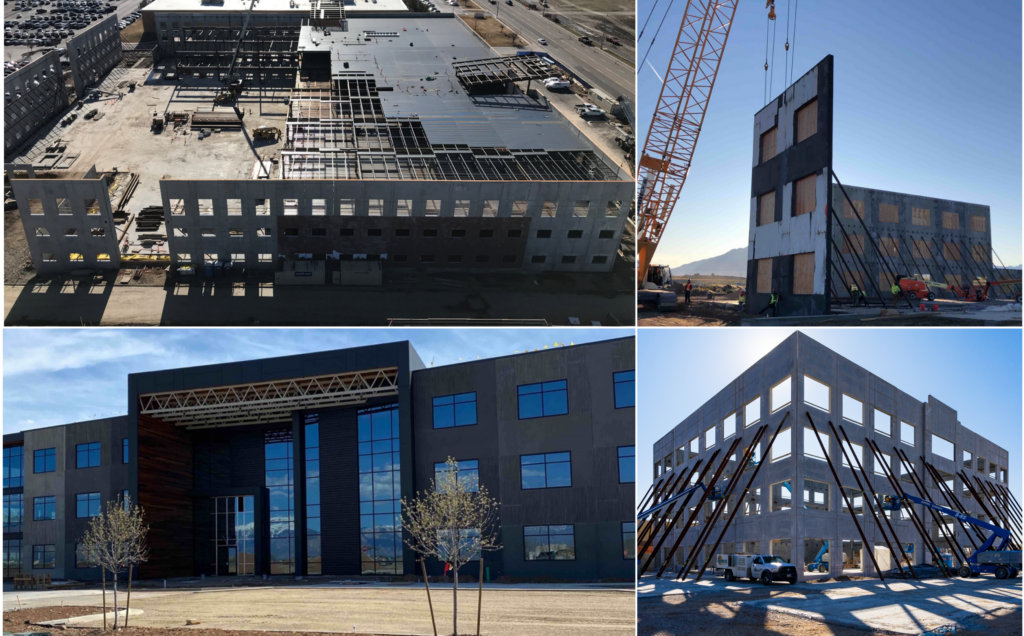Perhaps in your explorations of YouTube you have stumbled across a “Will it Taco?” or “Will it Blend?” video. In these videos, the makers ask one simple question: are we able to do this? Whether we are asking if a chicken pot pie will taco or whether an iPad will blend, we as people are always pushing the limits of what can or cannot be done. As we encounter new methods of construction and push the limits of design, we at Dunn Associates, Inc. will often ask ourselves “Will it Tilt?”
The idea behind tilt-up construction is simple: instead of pouring concrete vertically, why don’t we pour it on the ground? This allows an entire wall to be poured at the same time and eliminates the need for different pouring lifts, as well as save countless hours building formwork and tying rebar off the ground.
 Tilt-Up Construction – Pour, Tilt, Brace (Photos of UPS Distribution Hub in Salt Lake City)
Tilt-Up Construction – Pour, Tilt, Brace (Photos of UPS Distribution Hub in Salt Lake City)
Tilt-up construction has pushed the envelope on rapid construction, allowing the shell of massive buildings to be constructed in a fraction of the time. For this reason, tilt-up design has revolutionized the warehouse and distribution market. However, as more and more people see the benefits of tilt-up construction, we have seen a push to the multi-story applications as well.
Warehouse and Distribution
I am sure as you have driven on the freeway, you have passed right by them. Unless you are looking for them, you may overlook them entirely. However, if you pay close attention, you may notice clusters of massive single-story buildings. These massive “box-like” structures are often used as warehouse space, department stores, or distribution offices.
As engineers, we often grow to appreciate the “box” structures. In school they teach us based on a regular box building with very little interesting features. It may be easy to get sucked into the attitude that all we are designing for a tilt-up warehouse is one big box.
Having designed and worked on many tilt-up warehouses, one thing I have grown to appreciate at Dunn Associates is that it is never just a box. Each new tilt-up building brings its own set of challenges, and it is exciting to balance economy with design as we look at these giant buildings under a microscope. Most tilt-up walls are slender, meaning they are relatively thin for how tall they are. A typical wall that is 44 feet tall may be as thin as 10” thick at times! This presents several challenges as the engineer, each of which need to be addressed to ensure the building will be safe.
One other consideration in the warehouse world is the scale of economy. Because these buildings are often large in scale, one small change can greatly impact the cost of the structure. Making the panels on a warehouse even ½” thicker could result in tens of thousands of dollars in construction. Each piece going into the design must be carefully chosen because the same piece is going to be used hundreds and hundreds of times.
So how does tilt-up design work in the single-story warehouse space? One of the main driving forces in design is the thickness of the panel. Most often this is governed by the out-of-plane forces that are acting on the panel i.e. the forces in the thinner direction of the panel. Think of a ruler, if you were to grab the top and bottom of the ruler, how much effort does it take to bend it? In one direction, the ruler is skinnier (more slender) and bends with much less effort. This same thing can happen with tilt-up walls – remember the wall is considered slender. We, as the engineer, need to find the balance to make the wall thick enough that it does not bend like your ruler, but not too thick so as to add additional cost to the project.
Multi-Story Tilt-Up Construction
As the world of single-story tilt-up warehouse construction thrives and continues to grow, many developers and contractors are asking if these same principles can be applied to office buildings. Here at Dunn Associates, we answer with a resounding “Yes”! Several buildings have challenged the question “Will it Tilt?” within the Salt Lake Valley, like those shown below:
 Various Multi-Story Tilt-Up Projects in Salt Lake City (Airport Technology Park Building ‘G’, Project Unity near the Airforce Museum, Medical Office Building in Ogden)
Various Multi-Story Tilt-Up Projects in Salt Lake City (Airport Technology Park Building ‘G’, Project Unity near the Airforce Museum, Medical Office Building in Ogden)
Many aspects of the tilt-up design remain the same as we look at the multi-story tilt design. However, the game gets more complicated as we look at the other floors. As we add floors, and as our building gets taller, the structural design code kicks us to more stringent requirements than our single-story warehouses. More stringent reinforcement must be used within the concrete, more coordination must occur concerning openings in tilt-up panels, and more forces are being applied to our walls. Oftentimes, more vigorous analysis procedures must also be performed to combat irregularities in our structures.
While relatively new to the Salt Lake Valley, multi-story tilt-up design is beginning to take off as a viable construction alternative for office buildings. It has been exciting to investigate what current office buildings would look like if it were a tilt-up building. I often imagine what kind of challenges may present themselves and afterwards looking back and wondering, “Will it Tilt?”
So When will it Tilt?
Just like any other building system, be it moment frame, wood shear wall or brace frame, there are certain applications where tilt-up construction may make the most sense. Here are some questions you may want to ask yourself if you are thinking tilt-up construction may be applicable for your building:
- Does my building have a small or a large footprint?
Many tilt-up buildings typically have a large footprint. While not a requirement, a large footprint does help with the construction of the tilt panels. Because the panels are built and poured on the ground, often the slab is used as the casting location for the tilt-up panels, so a large area helps provide room to pour the panels. - Is my building in a congested area?
One of the advantages to tilt-up construction as opposed to conventional concrete construction is that all the concrete work is done on the ground. However, there will come a point where we need to lift the panels into place. A large crane may be required to pick up the panels, and if the building is in a tight neighborhood, it may be difficult to drive the crane around the building to place the panels. - Is my building over 5 stories?
While tilt-up construction has exceed 5 stories outside of Utah, the seismic loads within Utah make it difficult for tilt-up construction to go very high (for now!). It’s relatively new within the state but a different seismic system may be required if your building is too tall. - Is my building regularly shaped?
While it is not required for a building to be a standard box, most tilt-up panels come together at joints and it may be difficult if the building was circular. Often the tilt-up panels replace much of the exterior skin required on buildings (the panel is the skin), so if the building’s perimeter is irregular, it may make it difficult to have panels on the perimeter.
Oftentimes when people thing of a warehouse, they may think it is just another big dumb box. But one thing I have loved about designing tilt-up buildings is that it is never just a box. Each building is unique, and we get to look at innovative ways of making something better. Whether it’s a single-story warehouse, or a tilt-up office building, no two buildings are the same, and I love the opportunity of learning with each tilt-up building I’ve worked on. Tilt-up buildings provide us with the opportunity to innovate and think outside the box. Next time you look at a building, consider asking yourself, “Will it Tilt”?
Written by Jake
Engineer
Jake loves doing anything outside; whether that be sports, hiking, fly fishing, or spending time in Utah’s great outdoors. One of his favorite activities is to hike around the mountains with his wife exploring new areas or going down a familiar trail. He is grateful for any time he is able to spend with his family, and always is willing to do anything for them. He is passionate about learning and finding new ways to better himself, not only in his career, but also as a husband, brother and person.


